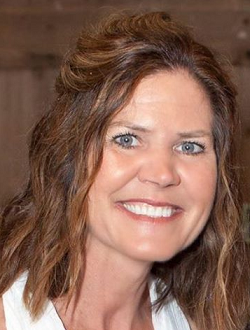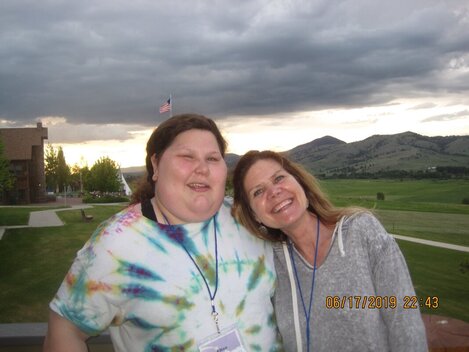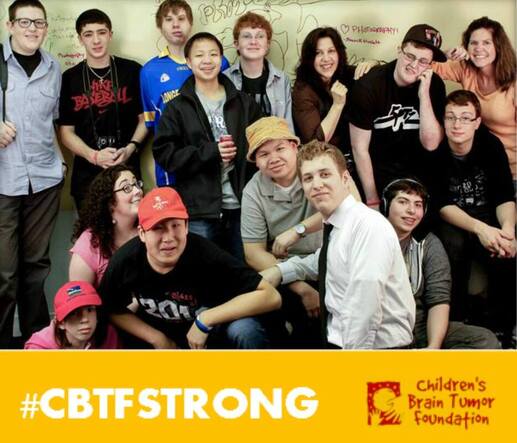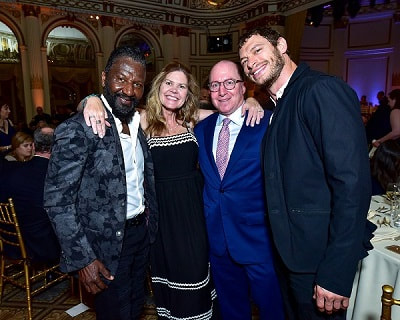January 2020 Featured Interview
|
|
Interview with
Stacia Wagner
President of the Children's Brain Tumor Foundation
Photo Courtesy: Children's Brain Tumor Foundation
About Stacia:
When a parent, sibling or child hears the words "Your child has a brain tumor," life goes into a complete tailspin. As President of the Children's Brain Tumor Foundation (CBTF), Stacia Wagner wants to guarantee no family goes through this journey alone.
As a leader in the childhood cancer/brain tumor community for over 20 years, Stacia began her work with CBTF 13 years ago as Director of Survivor Programs and is currently President of CBTF. Stacia supervised the creation of career programs for survivors, the first father/survivor program in the country, and many on-going face-to-face and online support groups. She has published and presented in multiple areas related to survivorship issues.
CBTF makes sure families are connected, supported, and have the knowledge to get through each stage of the journey.
“Once a family is with us, they are part of our larger family forever,” Stacia says.
When a parent, sibling or child hears the words "Your child has a brain tumor," life goes into a complete tailspin. As President of the Children's Brain Tumor Foundation (CBTF), Stacia Wagner wants to guarantee no family goes through this journey alone.
As a leader in the childhood cancer/brain tumor community for over 20 years, Stacia began her work with CBTF 13 years ago as Director of Survivor Programs and is currently President of CBTF. Stacia supervised the creation of career programs for survivors, the first father/survivor program in the country, and many on-going face-to-face and online support groups. She has published and presented in multiple areas related to survivorship issues.
CBTF makes sure families are connected, supported, and have the knowledge to get through each stage of the journey.
“Once a family is with us, they are part of our larger family forever,” Stacia says.
About Children's Brain Tumor Foundation (CBTF):
The Children’s Brain Tumor Foundation (CBTF) is a nonprofit organization focused on improving the treatment, quality of life, and long-term outlook for children and families affected by a brain or spinal cord tumor. Founded in 1988, CBTF connects survivors, parents, and siblings through creative, evidence-based programs designed and directed by a professional staff. CBTF works with over 230 children’s hospitals to provide support and programs to families at the time of diagnosis, after treatment, and to bereaved families.
The need for collaboration inspired the founding of the Childhood Brain Tumor Tissue Consortium (CBTTC). CBTTC is the first biorepository of brain tumor tissue from multiple institutions of its kind.
The Children’s Brain Tumor Foundation (CBTF) is a nonprofit organization focused on improving the treatment, quality of life, and long-term outlook for children and families affected by a brain or spinal cord tumor. Founded in 1988, CBTF connects survivors, parents, and siblings through creative, evidence-based programs designed and directed by a professional staff. CBTF works with over 230 children’s hospitals to provide support and programs to families at the time of diagnosis, after treatment, and to bereaved families.
The need for collaboration inspired the founding of the Childhood Brain Tumor Tissue Consortium (CBTTC). CBTTC is the first biorepository of brain tumor tissue from multiple institutions of its kind.
Myrna Beth Haskell, managing editor, spoke with Stacia about her role as president and how the foundation aims to help families and children affected by a brain or spinal cord tumor.
|
What was the inspiration behind the founding of CBTF?
The organization was founded in 1988 by a group of parents from New York. These parents found that they couldn’t find quality resources that would help them navigate medical information as well as life issues that arise when you’re caring for a child with a brain tumor. Many of these same parents are still with the organization today. We strive to make sure that families don’t have to go through this alone, so a focus is on improving quality of life for the child and his or her family. We work with families from the time of diagnosis and throughout the brain tumor journey. Life after a brain tumor never looks as it did before. After the lifesaving medical treatment, there is nothing more important than being surrounded by others who understand your journey and to be empowered with the information needed to help navigate what the future holds. |
"When you first hear that your child has a brain tumor, you stop – you stop thinking, stop breathing, and - for a moment – you just stop living. As the doctors attempt to explain, you can’t process what they are saying. In the middle of the night, you go online to search – for an answer, for a reason, for anything to stop the insanity. And then CBTF comes into the picture, and you realize that your child is not the only one with this type of diagnosis. You learn that there are people who understand, who can give you information, who can give you emotional support, who can point you in the right direction. You become part of the CBTF family, and…slowly but surely…you are once again able to start thinking and breathing and moving forward." ~ Lori, mother of a child survivor |
How long have you been president of the organization? What are your responsibilities?
I’ve been with CBTF for 13 years. I started as Director of Survivor Programs. My training is with the psychosocial aspects of the journey, and my focus is to find ways to improve quality of life. I’m responsible for fundraising, program creation and quality of life research. My research area focuses on how brain tumors affect social skills and career development.
We utilize our programs to gather data so that we can assess the needs of families. Families fill out surveys to help us find out where the gaps are. For young children, the surveys include the entire family and follow the family from diagnosis through post-treatment. Other surveys focus on motivation and social skills.
One of the things we found out through this assessment process is that siblings needed support as well. So we established an online bereavement mentor program for siblings.
|
|
It’s been over 31 years since the organization’s inception. Have its goals changed at all along the way?
Originally, the majority of the funding went to basic medical research. However, the parents were requesting a need for peer support. We trained some of the parents as mentors. We also learned along the way that teenagers weren’t getting the support they needed. Schools and peers weren’t equipped to understand how to handle these teens. The teen years are tough for any adolescent, but many of these young people were being perceived as lacking leadership or having low intelligence. Of course, this is not true. We were also recognizing that each transition period for these children was extremely difficult, and many were becoming socially isolated. Adapting to college and remaining in employment are also issues. |
Some of these issues - the difficulty with transitions and social isolation - seem similar to what children on the autism spectrum experience.
Yes! You’re right! The social skills piece is something many of these children have to work on because they’re dealing with processing delays or a very literal interpretation of language and experiences. We’ve looked at how the autism community has handled social skill development.
But sometimes it can just be that a brain tumor has caused facial paralysis. In this case, someone with a great resume and education might go into an interview and be rejected because of how he or she looks.
In some ways, though, these young people are very mature – they certainly aren’t superficial.
Yes! You’re right! The social skills piece is something many of these children have to work on because they’re dealing with processing delays or a very literal interpretation of language and experiences. We’ve looked at how the autism community has handled social skill development.
But sometimes it can just be that a brain tumor has caused facial paralysis. In this case, someone with a great resume and education might go into an interview and be rejected because of how he or she looks.
In some ways, though, these young people are very mature – they certainly aren’t superficial.
Stacia (right) with Elise
Photo Courtesy: Children's Brain Tumor Foundation
Photo Courtesy: Children's Brain Tumor Foundation
What are some of the differences with pediatric cases as opposed to brain tumors in adults?
Many pediatric brain tumors are different than adult tumors in type.* The pediatric survival rate is also higher. Seventy-six percent of children with brain tumors survive. This means they will need to learn to adapt to life that is different from the one they knew.
Government funding for pediatric brain tumors is very low as compared to funding for adults. And the research on childhood cancers often leaves brain tumor cases out – the outcomes are so different that these cases complicate the findings and conclusions.
*Brain tumors in children typically come from different tissues than those affecting adults. Treatments that are fairly well-tolerated by the adult brain (such as radiation therapy) may prevent normal development of a child's brain, especially in children younger than age five. (American Association of Neurological Surgeons)
Many pediatric brain tumors are different than adult tumors in type.* The pediatric survival rate is also higher. Seventy-six percent of children with brain tumors survive. This means they will need to learn to adapt to life that is different from the one they knew.
Government funding for pediatric brain tumors is very low as compared to funding for adults. And the research on childhood cancers often leaves brain tumor cases out – the outcomes are so different that these cases complicate the findings and conclusions.
*Brain tumors in children typically come from different tissues than those affecting adults. Treatments that are fairly well-tolerated by the adult brain (such as radiation therapy) may prevent normal development of a child's brain, especially in children younger than age five. (American Association of Neurological Surgeons)
Are the side effects of radiation and other treatments more severe for children?
There’s a high risk for secondary cancer from radiation. Children can also develop cardiac disease or cardiopulmonary problems from chemical agents. [A host of other late effects, including cognitive impairments, are also possible.*]
We’ve learned that localized radiation produces the same results with fewer complications later on.
An important resource is The Childhood Cancer Survivor Study (St. Jude Children’s Research Hospital).**
*More information about this topic can be found from the American Cancer Society’s post on “Late Effects of Childhood Cancer Treatment.”
**This study collected data from 3,000 survivors diagnosed with cancer from 1987 to 1999. Its purpose was to gain new knowledge about the long-term effects of therapies in order to design treatment protocols and strategies to increase survival and minimize harmful health effects.
I’d love to know more about your signature programs (the Young Adult Heads Up Conference, etc.). What are some of the goals of these programs?
There’s a high risk for secondary cancer from radiation. Children can also develop cardiac disease or cardiopulmonary problems from chemical agents. [A host of other late effects, including cognitive impairments, are also possible.*]
We’ve learned that localized radiation produces the same results with fewer complications later on.
An important resource is The Childhood Cancer Survivor Study (St. Jude Children’s Research Hospital).**
*More information about this topic can be found from the American Cancer Society’s post on “Late Effects of Childhood Cancer Treatment.”
**This study collected data from 3,000 survivors diagnosed with cancer from 1987 to 1999. Its purpose was to gain new knowledge about the long-term effects of therapies in order to design treatment protocols and strategies to increase survival and minimize harmful health effects.
I’d love to know more about your signature programs (the Young Adult Heads Up Conference, etc.). What are some of the goals of these programs?
|
Team CBTF
Photo Courtesy: Children's Brain Tumor Foundation |
Attendees are either still in treatment or they are survivors. We collaborate with Camp Mak-a-Dream* for our Young Adult Heads Up Conference (ages 18 to 35) and our Teen Heads up Conference (ages 13 to 18). These programs empower survivors by educating them about career development, cognition, healthy living, peer relationships, etc. The programs are camp-based, so there are a lot of team building exercises – they don’t even realize they’re learning! There’s also plenty of time for fun.
The younger children attend programs with family members and participate in family-based activities. I recently attended a program, and it was one of the most empowering weeks I’ve ever experienced! I particularly remember the dance party. These kids usually don’t attend these types of social functions at their schools because it’s awkward. Usually, it’s the very first time that they feel like they’re fitting in, or it might be the first time they have the courage to ask someone to go out on a date. We also learned that dads needed unique support – a program that would enable them to make connections with other dads and to create stronger bonds with their children. They wanted to become more comfortable talking to their kids about dating and friendships. A group in NJ meets two times per week to nurture these relationships and connections. We hope to expand this opportunity for dads.** |
Along with the in-person programs and support groups, CBTF offers online programs and resources.
The common denominator: instant families and friendships are formed through these programs.
*Camp Mak-a-Dream helps survivors and their families live with and beyond cancer.
**A retreat (three-day camp experience) was also designed specifically for dads and survivors ages 10 to 22. This experience includes educational and supportive discussions. (CBTF website)
For more about CBTF’s signature programs: Email: [email protected] or Call: 212-448-9494.
The common denominator: instant families and friendships are formed through these programs.
*Camp Mak-a-Dream helps survivors and their families live with and beyond cancer.
**A retreat (three-day camp experience) was also designed specifically for dads and survivors ages 10 to 22. This experience includes educational and supportive discussions. (CBTF website)
For more about CBTF’s signature programs: Email: [email protected] or Call: 212-448-9494.
Tell me a bit about the Children’s Brain Tumor Tissue Consortium (CBTTC)?
It’s an open repository where any scientist can get samples for their own research. It’s easily accessible. This enables research scientists the ability to collaborate and work together in search of a cure.
CBTTC is dedicated to finding new innovative treatments for all types of childhood brain tumors through open-source data sharing, pooling of biospecimens, and real-time global research collaboration capabilities to fast-track and boost bench-to-bedside innovations.
It’s an open repository where any scientist can get samples for their own research. It’s easily accessible. This enables research scientists the ability to collaborate and work together in search of a cure.
CBTTC is dedicated to finding new innovative treatments for all types of childhood brain tumors through open-source data sharing, pooling of biospecimens, and real-time global research collaboration capabilities to fast-track and boost bench-to-bedside innovations.
|
Your research grants total 10.5 million dollars and have gone to leading doctors and researchers at top institutions and hospitals. How are hospital research programs chosen? Scientists reach out to the consortium and our scientific advisory board vets the research projects. Most funding goes toward early research – often a catalyst to a larger research project. CBTF’s philanthropic partner Licensing International (formerly LIMA), has donated $6.5 million to CBTF, restricting those funds first for the creation and support of the CBTTC and second for critical brain tumor cures and treatments. (CBTF website) |
Stacia in Group Photo at CBTF's "Dream & Promise Gala"
Lionel Leventhal, CBTF Board Chairman (3rd from left) |
I love the fact that you have a child-friendly resource for very young children. The creator of Parker’s Brain Storm is Jennifer Moliterno. Was she a survivor? I heard that the digital version uses the voices of survivors.
Jennifer had a friend who had a brain tumor. The book is free and comes with a bear. And, yes, there is also a digital version.
We correspond with parents who request a book to see if they’d like to talk with another parent (one we have vetted as a mentor) – we try to link parents with other parents who have kids close in age. It’s a way for parents to learn from others who share ‘this worked for me.’ Practical advice is invaluable.
Tell me about the endurance race fundraisers. Are these new?
This was Kayla Giacin’s idea.* She is a brain cancer survivor who found that running was a great stress reliever. She decided to run in the New York City Marathon and wanted to get more people involved. There are now 10 runners in New York and 4 runners in San Francisco. I was on the sidelines watching the CBTF runners go by. I couldn’t stop crying. It was such an inspirational and emotional experience – sharing their accomplishments and observing how far they had come.
*Kayla Giacin is currently the manager of Quality of Life Programs and Marketing for CBTF.
What types of volunteer opportunities do you have?
There are volunteer opportunities at any location where we host group programs, and there are also ways people can get involved with fundraising. The young professional group in New York has career mentorship. This is a great program because survivors can connect with peers in the industry they want to work in.
Your readers who want to learn more can send an email to: [email protected]
Is there anything else you’d like our readers to know?
I had cancer in college, and I wound up getting involved with a young adult survivor movement. I was interested in the social piece [how these survivors were getting along with peers, teachers, employers and others in the community]. My heart went out to young people with brain tumors because I felt their needs weren’t being addressed – both awareness and support resources were lacking. I knew that I wanted to focus on advocacy and work to make improvements in these areas.
Where do you find sanctuary (#WheresYourSanctuary)
I find sanctuary in what I do and with my family.
Jennifer had a friend who had a brain tumor. The book is free and comes with a bear. And, yes, there is also a digital version.
We correspond with parents who request a book to see if they’d like to talk with another parent (one we have vetted as a mentor) – we try to link parents with other parents who have kids close in age. It’s a way for parents to learn from others who share ‘this worked for me.’ Practical advice is invaluable.
Tell me about the endurance race fundraisers. Are these new?
This was Kayla Giacin’s idea.* She is a brain cancer survivor who found that running was a great stress reliever. She decided to run in the New York City Marathon and wanted to get more people involved. There are now 10 runners in New York and 4 runners in San Francisco. I was on the sidelines watching the CBTF runners go by. I couldn’t stop crying. It was such an inspirational and emotional experience – sharing their accomplishments and observing how far they had come.
*Kayla Giacin is currently the manager of Quality of Life Programs and Marketing for CBTF.
What types of volunteer opportunities do you have?
There are volunteer opportunities at any location where we host group programs, and there are also ways people can get involved with fundraising. The young professional group in New York has career mentorship. This is a great program because survivors can connect with peers in the industry they want to work in.
Your readers who want to learn more can send an email to: [email protected]
Is there anything else you’d like our readers to know?
I had cancer in college, and I wound up getting involved with a young adult survivor movement. I was interested in the social piece [how these survivors were getting along with peers, teachers, employers and others in the community]. My heart went out to young people with brain tumors because I felt their needs weren’t being addressed – both awareness and support resources were lacking. I knew that I wanted to focus on advocacy and work to make improvements in these areas.
Where do you find sanctuary (#WheresYourSanctuary)
I find sanctuary in what I do and with my family.






